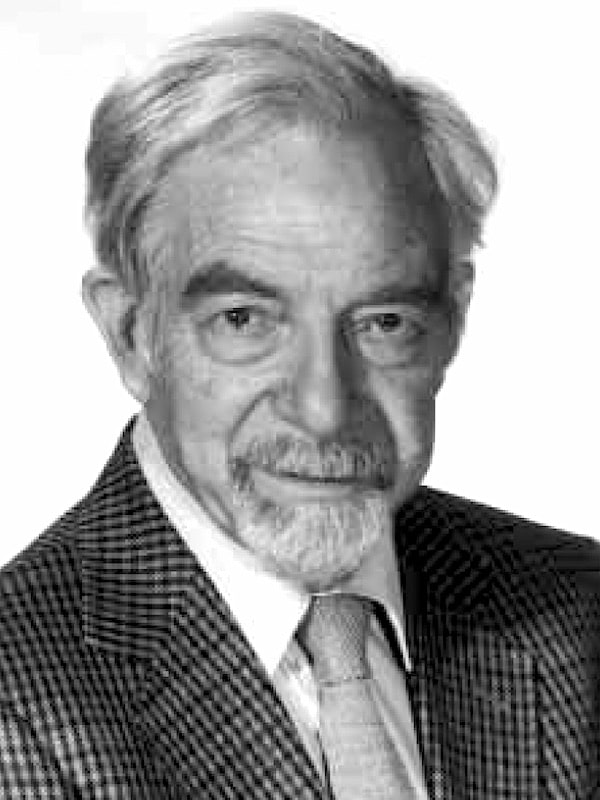B. Raymond Fink
Bernard Raymond Fink (1914 – 2000) was a British-American anesthesiologist.
Clinician and innovator with scholarly intellect and research insights. More than 120 original articles that explored diffusion anoxia, medical history, pain, respiratory regulation, electromyography, anaesthetic toxicity, cell metabolism, local anaesthetics and nerve conduction. Dr. Fink lectured in seven languages to 17 nations on five continents.
Eponymously remembered for his description of diffusion anoxia/hypoxia or the Fink effect; multiple airway adjuncts including the Fink Laryngoscope Blade, Fink Vallecular Airways and the Fink Non-rebreathing Valve
Biography
- Born on May 25, 1914, in London, England; raised in Antwerp, Belgium
- 1938 – BSc Physiology, University of London
- 1939-1945 Completed medical training and service in South Africa; Member of the South African Medical Corps
- 1950 – Emigrated to the United States
- 1952 – Completed anesthesia residency Beth Israel Hospital, New York; associate professor of anesthesia, Columbia University.
- 1964 – Professor of anesthesia University of Washington
- 1987 – ASA Excellence in Research Award (American Society of Anesthesiologists)
- 1993 – ASA Distinguished Service Award
- Died on October 30, 2000
Medical Eponyms
Fink effect (1955)
Diffusion anoxia/hypoxia or the third gas effect.
Study of eight patients undergoing gynaecologic surgery with 75% nitrous oxide – 25% oxygen mix. Fink noted that the patients’ oxygen saturations dropped 5-10% upon cessation of nitrous oxide and ventilation of room air. This lead to the conclusion that oxygen should routinely be given at the end of sedation.
The underlying mechanism of diffusion hypoxia is that given nitrous oxide is poorly soluble in blood, once the driving force of high alveolar nitrous oxide concentration is removed, its will diffuse rapidly back from the blood into the alveolar space, diffuse and possibly displace end alveolar O2 and CO2. The decrease in partial pressure of O2 leads to hypoxia, whilst the decrease in CO2 can potentially suppress ventilation further worsening the hypoxia. Although the effect does not last long, it can be prevented by increasing the concentration of inspired oxygen.
The significance of the Fink effect has since been downplayed through other work that suggests airway obstruction, alveolar atelectasis and other respiratory irregularities play a larger role than diffuse hypoxia. However, given its sound physiologic underpinning and absence of evidence that rule out the phenomenon. It’s still prudent to place some O2 on anyone given nitrous sedation.
Fink Laryngoscope Blade (1958)
Wider and with a shallower curve than the Macintosh Laryngoscope blade, for use with difficult to intubate adults. It came in only one size, size 4
Macintosh Laryngoscope Blade widened to improve balance and reduced in height to protect the teeth. The recurved tip fits the vallecula, greatly facilitating exposure in difficult cases. The forward light gives good illumination and simplifies bulb replacement.
Foregger, 1958
Other eponyms
Fink Non-rebreathing Valve (1954) first non-rebreathing valve that allowed the anesthesiologist to provide assisted respirations with only one hand so that the opposite hand was free to attend to other responsibilities and patient needs.
Fink Vallecular Airway – additional rounded extension to the end of the oral airway to reach the vallecula and indirectly raise the epiglottis. Fink recommended his vallecular airway in patients whose airways became obstructed during anesthesia despite the use of a standard oral airway
Major Publications
- Fink BR. A nonrebreathing valve of new design. Anesthesiology. 1954; 15(5): 471-4.
- Fink BR. Diffusion anoxia. Anesthesiology. 1955; 16(4): 511-9. [Fink effect]
- Fink BR, Basek M, Epanchin V. The mechanism of opening of the human larynx. The Laryngoscope, 1956; 66: 410–425.
- Fink BR. Roentgenographic studies of the oropharyngeal airway. Anesthesiology. 1957; 18(5): 711-8
- Fink BR. Human Larynx – A Functional Study. New York: Raven Press, 1975
- Fink BR, Demarest RJ. Laryngeal Biomechanics. Harvard University Press, 1978
- Fink BR. Leaves and needles: the introduction of surgical local anesthesia. Anesthesiology. 1985; 63(1): 77-83.
References
Biography
- Epstein RM. ASA Award: B. Raymond Fink. Anesthes. 1987; 67(4):456-458.
- Bause G. Bernard Raymond Fink, M.D. ASA News. 2000; 64(12)
- McGoldrick KB. In Memoriam: B. Raymond Fink, M.D. (1914–2000) Survey of Anesthesiology 2001; 45(1): 1-2
- Maltby R. Notable Names in Anaesthesia. The Choir Press; 2013: 63-65
- Bibliography. Fink, B. Raymond. WorldCat Identities
Eponymous terms
- The Fink Edition. Bull Anesth Hist. 2001 Jan;19(1):24-6.
- Cheney FW. An early example of evidence-based medicine: hypoxemia due to nitrous oxide. Anesthesiology. 2007; 106(1): 186-8
- Fink Collection. The Wood Library-Museum.
[cite]
Doctor currently working in South Wales, training in anaesthetics. Graduated Leeds University with MB ChB with BSc in microbiology in relation to medicine. Special interests in emergency medicine, critical care and anaesthetics


